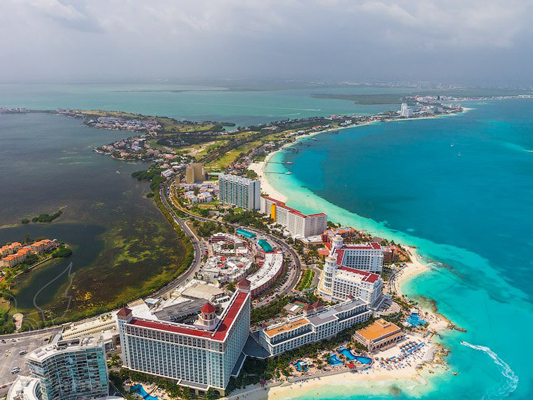Cancún (Spanish pronunciation: [kaŋˈkun]) is a city in southeastern Mexico, located on the southeast coast of the Yucatán Peninsula in the Mexican state of Quintana Roo. It is a major world-renowned tourist destination, as well as being the seat of the municipality of Benito Juárez. The city is located on the Caribbean Sea, and is one of the easternmost points in Mexico. Cancún is located just north of Mexico’s Caribbean coast resort band known as the Riviera Maya. There are two possible translations of Cancún, based on the Mayan pronunciation kaan kun. The first translation is “nest of snakes.” The second version and less accepted is “place of the gold snake.
The shield of the municipality of Benito Juárez, who represents the city of Cancun, was designed by the artist vital Jesús Carmichael Jiménez (Elio Carmichael). It is divided into three parts: The color blue symbolizes the Caribbean Sea, the yellow the sand and the red the sun with its rays.
The name Cancún, Cancum or Cankun first appears on 18th century maps.[citation needed] The meaning of Cancún is unknown, and it is also unknown whether the name is of Maya origin. If it is of Maya origin, possible translations include “Place/Seat/Throne of the Snake” or “Enchanted Snake”. Snake iconography was prevalent at the pre-Columbian site of Nizuc.
When development was started on January 23, 1970, Isla Cancún had only three residents, caretakers of the coconut plantation of Don José de Jesús Lima Gutiérrez, who lived on Isla Mujeres, and there were only 117 people living in nearby Puerto Juarez, a fishing village and military base. The city began as a tourism project in 1974 as an Integrally Planned Center, a pioneer of FONATUR (Fondo Nacional de Fomento al Turismo, National Fund for Tourism Development), formerly known as INFRATUR. Since then, it has undergone a comprehensive transformation from being a fisherman’s island surrounded by virgin forest and undiscovered shores to being one of the two most well-known Mexican resorts, along with Acapulco.
Apart from the island tourist zone (actually part of the world’s second-longest coral reef), the Mexican residential section of the city, the downtown part of which is known as “El Centro,” follows a master plan that consists of “supermanzanas” (superblocks), giant trapezoids with a central, open, non-residential area cut in by u-shaped residential streets. These open centers usually have walkways and ‘sidewalks’ around a central garden park, or soccer fields, or a library, etc. which make the mainland “Mexican” Cancún bicycle-friendly. The residential roads of central or ‘Mainland’ Cancún, U-shaped and culs-de-sacs, insulate housing from the noise and congestion of the main flow of traffic. Mainland Cancún has a central market that resembles an outlet mall, colorful buildings on a pedestrian city block. Ave. Tulum is the main north-south artery, connecting downtown to the airport, which is some 30 km (19 mi) south of downtown. Tulum is bisected by Ave. Cobá. East of Ave. Tulum, Cobá becomes Ave. Kukulcan which serves as the primary road through the 7-shaped hotel zone. Ave. Tulum ends on the north side at Ave. Paseo José López Portillo which connects to the main highway west to Chichén Itzá and Mérida. Another major north-south road is Ave. Bonampak which runs roughly parallel to Ave. Tulum. The main ferry to Isla Mujeres is located in Puerto Juarez, on Ave. Paseo José López Portillo.
Cancún has a tropical climate, specifically a tropical wet and dry climate (Köppen Aw), with few temperature differences between seasons, but pronounced rainy seasons. The city is warm year-round, and moderated by onshore trade winds, with an annual mean temperature of 27.1 °C (80.8 °F). Unlike inland areas of the Yucatán Peninsula, sea breezes restrict high temperatures from reaching 35 °C (95 °F) on most afternoons. Annual rainfall is around 1,340 millimetres (52.8 in), falling on 115 days per year. More temperate conditions occur from November to February with occasional refreshing northerly breezes, it is drier and becomes hotter in March and April. It is hottest from May to September, due to proximity to the Caribbean and Gulf humidity is high the year round, especially so during hurricane season (averages close to 70% on rainfree days). The hotel zone juts into the Caribbean Sea, it is surrounded by ocean therefore daytime temperatures are around 1-2C less and windspeeds are higher than at the airport located some distance inland, which is the official meteorological station for Cancún, averages as shown below.
Cancún is served by Cancún International Airport with an added main runway that commenced operation as of October 2010. It has many flights to North America, Central America, South America, Asia, and Europe. It is located on the northeast of the Yucatán Peninsula serving an average of about fifteen million passengers per year. The airport is located around 20 km (12 mi) from the hotel zone, approximately a 20 minute trip by car. There is also a public transit bus system, servicing the hotel zone. The island of Isla Mujeres is located off the coast and is accessible by boat from Puerto Juárez.

